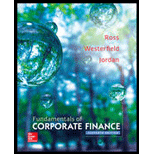
Fundamentals of Corporate Finance
11th Edition
ISBN: 9780077861704
Author: Stephen A. Ross Franco Modigliani Professor of Financial Economics Professor, Randolph W Westerfield Robert R. Dockson Deans Chair in Bus. Admin., Bradford D Jordan Professor
Publisher: McGraw-Hill Education
expand_more
expand_more
format_list_bulleted
Question
Chapter 5, Problem 1QP
Summary Introduction
To determine: The excess money received from the
Introduction:
Compound interest refers to the interest gained on the principal as well as the reinvested interest of previous periods. In other words, compound interest refers to the interest earned on the reinvested interest. Simple interest refers to the interest earned on the initial principal every year.
Expert Solution & Answer
Want to see the full answer?
Check out a sample textbook solution
Students have asked these similar questions
Purrogi Cat Treats Inc. earned $500 million last year and retained $290 million in earnings. What is the payout ratio?
Ethical dilemma:
Republic Communications Corporation (RCC) has offered you an attractive position in its financial planning division. The new position would constitute a promotion with a $30,000 increase in salary compared to the job you now have at National Telecommunications, Inc. (NTI). The problem is that RCC wants you to bring the rate-setting software you developed at NTI, along with some rate data, with you to the new job. Even though NTI sells its software to other companies and information concerning telephone rates is available to the public, you know that such knowledge will help RCC significantly in its attempt to redesign its rate-setting system. In fact, according to the situation presented in the text, a new and improved rate-setting program could be worth as much as $200 million per year for RCC. Therefore, the question is whether the information RCC wants you to take with you to your new job is proprietary to NTI. Should the rate-setting program and the rate data be…
Your traditional IRA account has stock of GFH, which cost $2,000 20 years ago when you were 50 years old. You have been very fortunate, and the stock is now worth $23,000. You are in the 32 percent income tax bracket and pay 15 percent on long-term capital gains.
a. What was the annual rate of growth in the value of the stock?
b. What are the taxes owed if you withdraw the funds?
Answer to part b. is $8,050
*Please display all work & needed formulas
Chapter 5 Solutions
Fundamentals of Corporate Finance
Ch. 5.1 - Prob. 5.1ACQCh. 5.1 - Prob. 5.1BCQCh. 5.1 - Prob. 5.1CCQCh. 5.2 - Prob. 5.2ACQCh. 5.2 - Prob. 5.2BCQCh. 5.2 - What do we mean by discounted cash flow, or DCF,...Ch. 5.2 - Prob. 5.2DCQCh. 5.3 - Prob. 5.3ACQCh. 5.3 - Prob. 5.3BCQCh. 5 - You deposited 2,000 in a bank account that pays 5...
Ch. 5 - Prob. 5.2CTFCh. 5 - Charlie invested 6,200 in a stock last year....Ch. 5 - Prob. 1CRCTCh. 5 - Compounding [LO1, 2] What is compounding? What is...Ch. 5 - Prob. 3CRCTCh. 5 - Compounding and Interest Rates [LO1, 2] What...Ch. 5 - Prob. 5CRCTCh. 5 - Prob. 6CRCTCh. 5 - Prob. 7CRCTCh. 5 - Prob. 8CRCTCh. 5 - Prob. 9CRCTCh. 5 - Prob. 10CRCTCh. 5 - Prob. 1QPCh. 5 - Prob. 2QPCh. 5 - Calculating Present Values [LO2] For each of the...Ch. 5 - Calculating Interest Kates [LO3] Solve for the...Ch. 5 - Prob. 5QPCh. 5 - Calculating Interest Rates [LO3] Assume the total...Ch. 5 - Prob. 7QPCh. 5 - Calculating Interest Rates [LO3] According to the...Ch. 5 - Calculating the Number of Periods [LO4] Youre...Ch. 5 - Prob. 10QPCh. 5 - Prob. 11QPCh. 5 - Prob. 12QPCh. 5 - Calculating Interest Rates and Future Values [LO1,...Ch. 5 - Calculating Rates of Return [LO3] Although...Ch. 5 - Prob. 15QPCh. 5 - Prob. 16QPCh. 5 - Calculating Present Values [LO2] Suppose you are...Ch. 5 - Prob. 18QPCh. 5 - Calculating Future Values [LO1] You are scheduled...Ch. 5 - Prob. 20QP
Knowledge Booster
Similar questions
- Can anyone figure this out correctly? I keep getting the wrong answers over and over? Cost of Trade Credit Grunewald Industries sells on terms of 3/10, net 40. Gross sales last year were $4,161,000 and accounts receivable averaged $370,500. Half of Grunewald's customers paid on the 10th day and took discounts. What are the nominal and effective costs of trade credit to Grunewald's nondiscount customers? (Hint: Calculate daily sales based on a 365-day year, calculate the average receivables for discount customers, and then find the DSO for the nondiscount customers.) Do not round intermediate calculations. Round your answers to two decimal places. 1.) Effective cost of trade credit:arrow_forwardExplain how an increase in interest rates by a central bank could affect bond prices and stock market performance. Explanation.arrow_forwardWhat is the purpose of diversification in an investment portfolio, and how does it reduce risk?arrow_forward
- Explain how an increase in interest rates by a central bank could affect bond prices and stock market performance.arrow_forwardWhat is the purpose of diversification in an investment portfolio, and how does it reduce risk? Need help!arrow_forwardWhat are the key differences between a company’s income statement and its cash flow statement? Why are both important for financial analysis? Need help!arrow_forward
- What are the key differences between a company’s income statement and its cash flow statement? Why are both important for financial analysis?arrow_forwardWhat is the relationship between risk and return in finance, and how is this reflected in the Capital Asset Pricing Model (CAPM)? Explain.arrow_forwardDefine the time value of money (TVM). How does TVM influence decision-making in capital budgeting? Explanation.arrow_forward
- What is the relationship between risk and return in finance, and how is this reflected in the Capital Asset Pricing Model (CAPM)?arrow_forward3. Explain the concept of compounding. How does compounding impact the future value of an investment? Need help!arrow_forward3. Explain the concept of compounding. How does compounding impact the future value of an investment?arrow_forward
arrow_back_ios
SEE MORE QUESTIONS
arrow_forward_ios
Recommended textbooks for you
